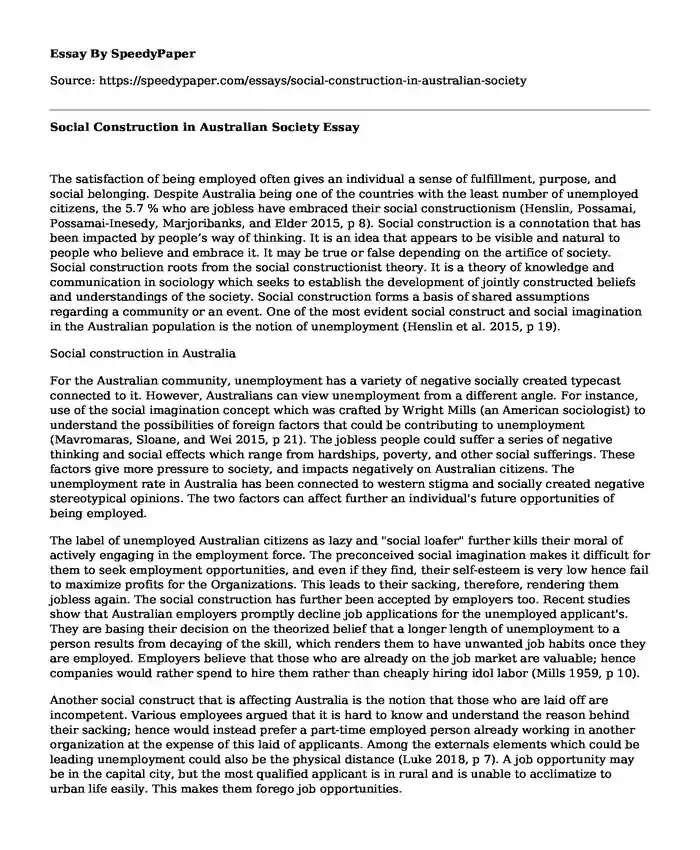The satisfaction of being employed often gives an individual a sense of fulfillment, purpose, and social belonging. Despite Australia being one of the countries with the least number of unemployed citizens, the 5.7 % who are jobless have embraced their social constructionism (Henslin, Possamai, Possamai-Inesedy, Marjoribanks, and Elder 2015, p 8). Social construction is a connotation that has been impacted by people's way of thinking. It is an idea that appears to be visible and natural to people who believe and embrace it. It may be true or false depending on the artifice of society. Social construction roots from the social constructionist theory. It is a theory of knowledge and communication in sociology which seeks to establish the development of jointly constructed beliefs and understandings of the society. Social construction forms a basis of shared assumptions regarding a community or an event. One of the most evident social construct and social imagination in the Australian population is the notion of unemployment (Henslin et al. 2015, p 19).
Social construction in Australia
For the Australian community, unemployment has a variety of negative socially created typecast connected to it. However, Australians can view unemployment from a different angle. For instance, use of the social imagination concept which was crafted by Wright Mills (an American sociologist) to understand the possibilities of foreign factors that could be contributing to unemployment (Mavromaras, Sloane, and Wei 2015, p 21). The jobless people could suffer a series of negative thinking and social effects which range from hardships, poverty, and other social sufferings. These factors give more pressure to society, and impacts negatively on Australian citizens. The unemployment rate in Australia has been connected to western stigma and socially created negative stereotypical opinions. The two factors can affect further an individual's future opportunities of being employed.
The label of unemployed Australian citizens as lazy and "social loafer" further kills their moral of actively engaging in the employment force. The preconceived social imagination makes it difficult for them to seek employment opportunities, and even if they find, their self-esteem is very low hence fail to maximize profits for the Organizations. This leads to their sacking, therefore, rendering them jobless again. The social construction has further been accepted by employers too. Recent studies show that Australian employers promptly decline job applications for the unemployed applicant's. They are basing their decision on the theorized belief that a longer length of unemployment to a person results from decaying of the skill, which renders them to have unwanted job habits once they are employed. Employers believe that those who are already on the job market are valuable; hence companies would rather spend to hire them rather than cheaply hiring idol labor (Mills 1959, p 10).
Another social construct that is affecting Australia is the notion that those who are laid off are incompetent. Various employees argued that it is hard to know and understand the reason behind their sacking; hence would instead prefer a part-time employed person already working in another organization at the expense of this laid of applicants. Among the externals elements which could be leading unemployment could also be the physical distance (Luke 2018, p 7). A job opportunity may be in the capital city, but the most qualified applicant is in rural and is unable to acclimatize to urban life easily. This makes them forego job opportunities.
Conclusion
It is clear that unemployment is viewed as a typical headache. By studying the reasons as to why the unemployed population has lost faith in joining the labor force, one will clearly understand that social construction is playing a manor role. Other external factors could be contributing to, but the society's connotations play a crucial role.
Reference List
Henslin, J.M., Possamai, A.M., Possamai-Inesedy, A.L., Marjoribanks, T. and Elder, K., 2015. Sociology: A down to earth approach. Pearson Higher Education AU. Accessed on 25th March 2019
https://books.google.com.au/books?hl=en&lr=&id=ujLiBAAAQBAJ&oi=fnd&pg=PP1&dq=Henslin,+JM+%26+Possamai-Inesedy,+A&ots=wsRRZkfbp9&sig=yRILLWfTqf9IjvA39-EQvqZ17Ss#v=onepage&q=Henslin%2C%20JM%20%26%20Possamai-Inesedy%2C%20A&f=false.
Luke, A., 2018. Critical literacy in Australia: A matter of context and standpoint. Critical Literacy, Schooling, and Social Justice (pp. 168-188). Routledge. Accessed on 25th March 2019
https://www.google.com/url?sa=t&source=web&rct=j&url=https://espace.library.uq.edu.au/view/UQ:139646&ved=2ahUKEwjondHQ5p3hAhUvA2MBHUQMBpYQFjABegQICRAB&usg=AOvVaw1uXPtwMyzSyoAF53yDWCU4&cshid=1553534418589.
Mavromaras, K., Sloane, P. and Wei, Z., 2015. The scarring effects of unemployment, low pay, and skills under-utilization in Australia compared. Applied Economics, 47(23), pp.2413-2429. Accessed on 25th March 2019
https://www.google.com/url?sa=t&source=web&rct=j&url=https://www.tandfonline.com/doi/abs/10.1080/00036846.2015.1008762&ved=2ahUKEwis1cqj5p3hAhXR1eAKHVrHBNoQFjAAegQIBBAB&usg=AOvVaw2pXAijdduQYFWmqqbVEpn3.
Mills, C. W. (1959). The sociological imagination. London, United Kingdom: Oxford University Press. Accessed on 25th March 2019
http://open.lib.umn.edu/socialproblems/chapter/1-2-sociological-perspectives-on-social-problems/.
Cite this page
Social Construction in Australian Society. (2022, Dec 09). Retrieved from https://speedypaper.com/essays/social-construction-in-australian-society
Request Removal
If you are the original author of this essay and no longer wish to have it published on the SpeedyPaper website, please click below to request its removal:
- Artificial Intelligence in the Working Process. Free Essay.
- Ethical Issues of Artificial Intelligence in this Ready-to-Download Free Essay
- Essay Sample Exploring Theories of Criminal Behavior
- Essay Example on a Psychological Aspect of a Cult
- Why Travelling is good for the Mind
- Free Essay Example on the Safety of the Staff
- Advising a Couple on Purchasing a House. Paper Example
Popular categories





